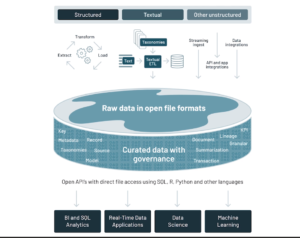
Databricks Sees Lakehouse Validation in $1.6 Billion Round

Databricks today announced a $1.6 billion Series H round of venture capital funding at a $38 billion valuation. The company says the new money validates its lakehouse approach to big data architecture, which blends the quality control of established data warehouses with the scale and flexibility of modern data lakes. It also announced the hiring of former Salesforce executive to be its new president of global field operations.
Since it was founded in 2013, Databricks has become one of the biggest and fastest growing companies in the big data space. That growth has entered hyper mode since October 2019, when the company completed a $400 million round at a $6.2 billion valuation. In February of this year–just six months ago–it landed a $1-billion Series G round at a $28 billion valuation. At this rate, the company may never need to have an initial public offering (IPO) of stock, which last October was rumored to be imminent in 2021.
The fact that Databricks is the commercial outfit behind Apache Spark may have driven some of the growth initially. Yes, Spark continues to be a critical data processing framework used by companies around the world, and is one of the core technologies in Databricks’ offering. But Databricks has become much more than just the company behind Spark, or even a proficient provider of a Spark software as a service (SaaS) or Spark runtime.
Indeed, Databricks’ continued ascent into the big data stratosphere appears to be linked more closely to the firm’s bet on the data lakehouse architecture, which it first unveiled with the launch of Delta in 2017. Since then, the lakehouse, which mixes concepts and ideas from older MPP-style data warehouses and newer Hadoop-style data lakes, has taken off in popularity, and even been emulated by other vendors, including Google Cloud and AWS.
Ali Ghodsi, Databricks co-founder and CEO, confidently asserted that the $1.6 billion Series H round is as much a validation of Databricks as a company than a bet on Databricks’ vision for the data lake house architecture.
“This new investment is a reflection of the rapid adoption and incredible customer demand we’re seeing for the Databricks Lakehouse Platform and underscores the industry and investor confidence in our vision–that lakehouse is the data architecture of the future,” Ghodsi stated in a press release. “This marks a thrilling new chapter that will allow us to accelerate our pace of innovation and further invest in the success of data-driven organizations on their journey to the lakehouse.”
The lakehouse architecture is being touted as a way to take advantage of an unprecented deluge of data, without turning the data lake into a data swamp. In particular, the lakehouse concept borrows established procdures that were developed during the data warehousing heyday, particularly regarding the tracking of raw data as it’s collected, keeping an accurate lineage of the data as it goes through the transformation process, and maintaining that focus on high quality, structured data for analytics and AI use cases.
During Databricks’ Data + AI Summit event in May, data warehouse expert Bill Inmon appeared alongside Ghodsi and applauded the lakehouse concept. “If they don’t build the lakehouse, they’re going have this mountain of data that sits there and nobody is going to be able to do anything with it,” Inmon said. “I believe that the lakehouse is going to unlock the data that is there and is going to present opportunities like we’ve never seen before.”
The San Francisco company also announced the hiring of Andy Kofoid to be its new president of global field operations. Kofoid comes to Databricks from Salesforce, where he most recently was president of the North America business unit, which had revenues of $12 billion and more than 8,000 employees.
“Databricks’ trajectory is incredible and I’m excited to join this outstanding organization and be part of the next chapter,” Kofoid stated in a press release. “I’ve seen firsthand the critical role that data and AI play in fueling digital transformation and I look forward to helping customers around the world maximize the value of their data with this best-in-class lakehouse platform that is redefining the next era in cloud.”
The Series H funding was led by Counterpoint Global, a part of Morgan Stanley. Joining Counterpoint were Baillie Gifford, ClearBridge Investments, and UC Investments, through the office of the chief investment officer of the Regents of the University of California. Existing investors also participated in the round, including Andreessen Horowitz and a dozen others.
Dennis Lynch, the head of Counterpoint Global, said he’s excited to invest in a company “whose lakehouse platform is reinventing analytics with the speed and scale customers require today. We believe the company is well positioned to become a platform of choice among forward-thinking enterprises that want to transform valuable data into strategic business insights,” Lynch said in a press release.
Related Items:
Lakehouses Prevent Data Swamps, Bill Inmon Says
Databricks Edges Closer to IPO with $1B Round
Databricks Puts ‘Delta’ at the Confluence of Lakes, Streams, and Warehouses





























